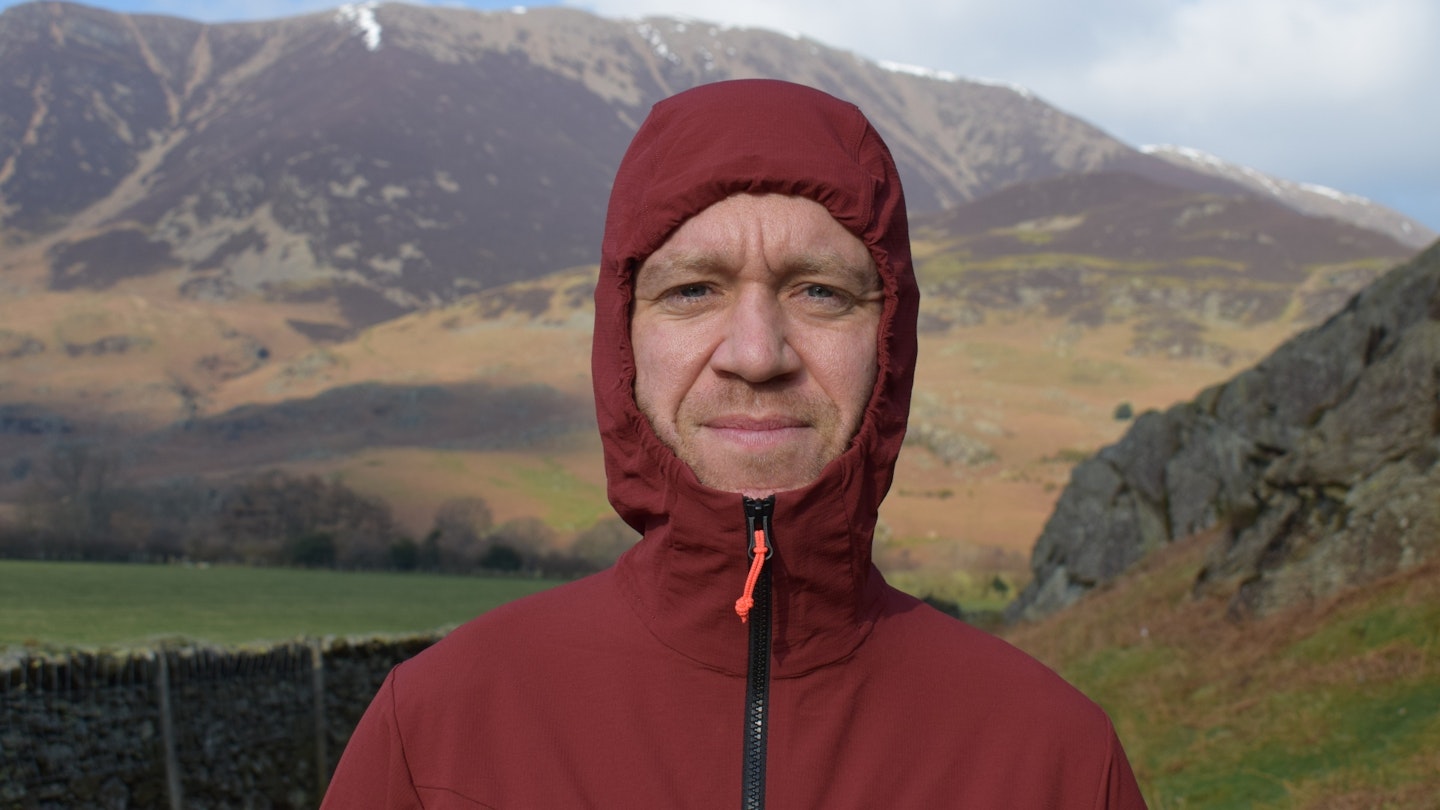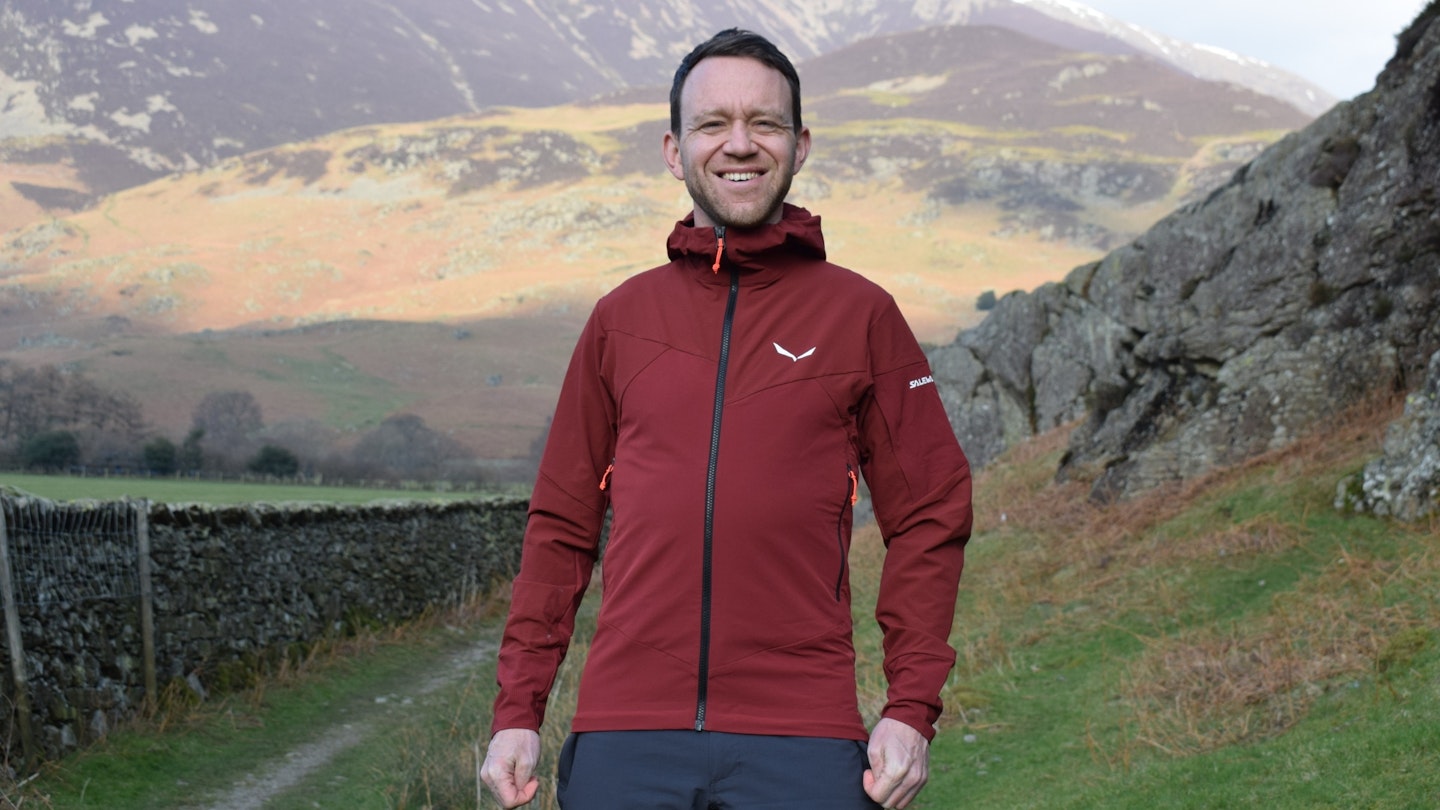On first impressions this Salewa jacket appears rather simplistic, with a minimalist style and only basic features. But, out on the hill, it transforms into a real gem – super-comfy, ultra-stretchy, wind-resistant, water-resistant, and with an athletic cut ideal for agile movement in the mountains.
While still just about fitting the bill as a classic-style softshell jacket, it is lighter and comfier than many others, and its real USP is how super-stretchy the fabric is. If you want a “normal” softshell jacket, but one with an ultralight, minimalist and athletic design, this is the softshell for you.
Pros
- Comfortable
- Super-stretchy
- Lightweight
Cons
- Expensive
- Some features missing
- Athletic fit won’t suit all body shapes
| Men’s sizes | S-XXL |
| Women’s sizes | 6-14 |
| Weight | 398g (men’s small) |
| Fabric | 196gsm Durastretch bamboo (64% recycled polyamide, 26% polyester, 10% elastane) |
Fabrics & Stretch
This softshell is made from a relatively sturdy 196gsm (grams per square metre) stretch-woven soft shell fabric with additional elastane. The fabric is called Durastretch Bamboo and is made up of 64% recycled polyamide, 26% polyester and 10% elastane. The ‘bamboo’ in the name refers to the use of carbonised bamboo on the fabric backer, which adds anti-microbial protection and increases the speed of moisture wicking, according to Salewa. Carbonised bamboo is created by heating bamboo to very high temperatures, processing the charcoal and then mixing it in with other materials using nanotechnology.

The Agner Durastretch’s fabric is PFC-free and has a DWR treatment. Some sections of the jacket use a slightly different variant of the Durastretch fabric, which is 71% recycled polyamide, 18% polyester and 11% elastane. Salewa says that all of the Durastretch fabrics used in this jacket are “tough and rock-resistant”. The stretch in the jacket is four-way stretch, working both vertically and horizontally.
During our test hikes, we’ve found the fabric light, comfy and super-stretchy, with good freedom of movement. It feels less boxy and rigid than many other classic softshells, and comfort levels are higher. It moves well with the body and it holds its shape well too during dynamic mountain antics - the waist hem doesn’t lift, for example, thanks to what Salewa calls its “free motion patterning” design.
Wind-Resistance & Water-Resistance
Salewa says this jacket has been extensively tested by the brand’s athlete team on the Cima Grande North Face and around the Dolomites. Their conclusion? The Agner is a go-to jacket “in spring, summer and autumn when you want windproof water-resistance in an active cut and durable stretch fabric with full functionality.”

During our test hikes in the (slightly less glamorous) Lake District, we found the jacket’s DWR-treated outer fabric coped fine with light drizzle, cut out the wind nicely and delivered decent breathability overall. Although we always paired the jacket with a hard shell whenever rain got heavier than a drizzle and - despite the light design - we still found it reasonably easy to work up a sweat in, although we do have a tendency to “run warm”.
Fit, Comfort & Weight
The Salewa Agner Durastretch has a very athletic cut. It is slim-fitting and figure-hugging. We are generally a men’s small in almost all brands, but the Agner men’s small was a little on the tight and overly-snug side - so you may want to consider sizing up. If you do get the right size, however, the athletic fit works excellently. It feels streamlined and snug for fast’n’light adventures, and works well as both a standalone outer or mid-layer underneath a hard shell. Salewa describes the cut as a “trim, climbing-specific fit”. Having praised the cut, however, the athletic style definitely won’t suit all body shapes, and indeed for some it may be completely inappropriate.
In terms of comfort, the Salewa Agner Durastretch performs well. This comfort comes more from the light, agile and stretchy feel of the fabric, rather than from a soft, plush interior. Indeed the interior is rather basic and not soft against the skin. This means you get a touch of warmth from the Agner, but it’s definitely not the toastiest softshell on the market.

The men’s small of this jacket weighs 398g on our scales. This is significantly lighter than many of the classic-style softshells we’ve reviewed recently, due to their heftier, chunkier designs. The Agner Durastretch is 137g lighter than the Alpkit Resolute, 115g lighter than the Helly Hansen Odin Pro Shield Hybrid Softshell and 129g lighter than the Keela Hydron. But it’s considerably heavier than the new breed of high-tech, modern softshells. The Agner Durastretch is 75g heavier than the Rab Vapour-Rise Summit and 119g heavier than the Mountain Equipment Aerotherm, for example.
Features: Pockets, Hood & Ventilation
We’d describe the Agner Durastretch as a stripped-back, no-frills softshell. A few features are present, but many others are missing in a bid to save grams.
You get two zippered handwarmer pockets, and one small zippered valuable pocket on the left arm across the bicep/tricep area. The handwarmer pockets are big enough to take an OS map, and are positioned high enough to accommodate a climbing harness or backpack hipbelt. The jacket’s waist hem is adjustable via two drawcord toggles and the pre-shaped hood is snug. And that’s it, really.

There are quite a few features noticeable for their omission. The elasticated wrist cuffs don’t have any Velcro and are non-adjustable. The hood is non-adjustable too, and it has a slightly reinforced rim but there’s no wired peak or visor. You don’t get any internal pockets and the main central zipper doesn’t have a stormflap.
Overall it would be fair to say that this jacket’s design is tailored more towards scramblers and climbers, rather than hillwalkers - but it still works well for the latter.
A super-stretchy soft shell with an athletic cut and minimalist design – but the wrist cuffs and hood are not adjustable.
About the author

James Forrest is a prolific peak bagger and long-distance walker who’s one of the most high-profile outdoor writers in the UK.
He writes regular features and route guides for Trail and has been one of our main gear testers for the last few years. James is based on the edge of the Lake District so when he isn’t off on his latest crazy adventure or challenge, he’s walking in his local fells.
James reviews every type of outdoor kit for Trail and is a real authority on everything you need for wild camping and packing light for a multi-day walk.
Don't forget to subscribe to the Live For The Outdoors newsletter to get expert advice and outdoor inspiration delivered to your inbox!








